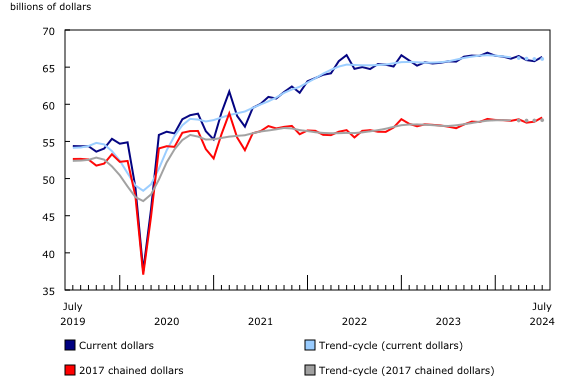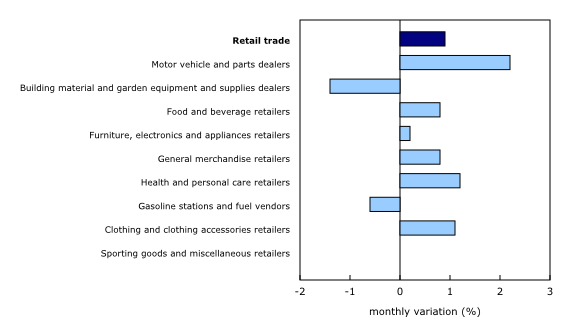Retail trade, July 2024
Released: 2024-09-20
$66.4 billion
July 2024
0.9% 
(monthly change)
$1.0 billion
July 2024
-0.6% 
(monthly change)
$0.3 billion
July 2024
1.1% 
(monthly change)
$1.8 billion
July 2024
1.6% 
(monthly change)
$1.5 billion
July 2024
0.9% 
(monthly change)
$15.0 billion
July 2024
1.5% 
(monthly change)
$24.5 billion
July 2024
-0.2% 
(monthly change)
$2.2 billion
July 2024
2.7% 
(monthly change)
$2.2 billion
July 2024
3.0% 
(monthly change)
$8.7 billion
July 2024
2.0% 
(monthly change)
$8.9 billion
July 2024
1.0% 
(monthly change)
$0.1 billion
July 2024
-1.9% 
(monthly change)
$0.1 billion
July 2024
3.1% 
(monthly change)
$0.1 billion
July 2024
3.1% 
(monthly change)
Retail sales increased 0.9% to $66.4 billion in July. Sales were up in seven of nine subsectors, led by increases at motor vehicle and parts dealers.
Core retail sales—which exclude gasoline stations and fuel vendors and motor vehicle and parts dealers—were up 0.6% in July.
In volume terms, retail sales increased 1.0% in July.
Sales up at motor vehicle and parts dealers
The largest increase in retail sales in July was observed at motor vehicle and parts dealers (+2.2%). Higher sales at new car dealers (+2.3%) led the increase, followed by other motor vehicle dealers (+5.6%). Lower sales at used car dealers (-0.8%) were offset by gains at automotive parts, accessories and tire retailers (+1.0%).
Sales at gasoline stations and fuel vendors (-0.6%) were down in July. In volume terms, sales at gasoline stations and fuel vendors decreased 1.7%.
Core retail sales rise
Core retail sales increased 0.6% in July, posting their second consecutive monthly increase. The gain was led by higher sales at food and beverage retailers (+0.8%) and general merchandise retailers (+0.8%). Sales at food and beverage retailers were up on higher sales at supermarkets and other grocery retailers (except convenience retailers) (+1.2%) and, to a lesser extent, specialty food retailers (+2.1%) and convenience retailers and vending machine operators (+0.4%).
Higher sales were also reported at health and personal care retailers (+1.2%) in July.
The largest decrease in core retail sales in July came from building material and garden equipment and supplies dealers (-1.4%).
Sales up in eight provinces
Retail sales increased in eight provinces in July. The largest provincial increase was observed in Quebec (+1.5%). In the census metropolitan area (CMA) of Montréal, sales were up 2.0%.
In Alberta, retail sales increased 2.0% in July, led by higher sales at motor vehicle and parts dealers.
The largest provincial decrease in retail sales in July was observed in Ontario (-0.2%). The decrease was led by lower sales at food and beverage retailers. In the CMA of Toronto, sales were down 1.2%.
Retail e-commerce sales in Canada
On a seasonally adjusted basis, retail e-commerce sales were up 3.4% to $4.1 billion in July, accounting for 6.1% of total retail trade, compared with 6.0% in June.
Advance retail indicator
Statistics Canada is providing an advance estimate of retail sales, which suggests that sales increased 0.5% in August. Owing to its early nature, this figure will be revised. This unofficial estimate was calculated based on responses received from 52.4% of companies surveyed. The average final response rate for the survey over the previous 12 months was 89.4%.
Did you know we have a mobile app?
Download our mobile app and get timely access to data at your fingertips! The StatsCAN app is available for free on the App Store and on Google Play.
Note to readers
All data in this release are seasonally adjusted and expressed in current dollars, unless otherwise noted.
Seasonally adjusted data are data that have been modified to eliminate the effect of seasonal and calendar influences to allow for more meaningful comparisons of economic conditions from period to period. For more information on seasonal adjustment, see Seasonally adjusted data – Frequently asked questions.
The percentage change for the advance estimate of retail sales is calculated using seasonally adjusted data and is expressed in current dollars.
This early indicator is a special unofficial estimate being provided to offer Canadians timely information on the retail sector. The data sources and methodology used are the same as those outlined on the Monthly Retail Trade Survey information page.
Trend-cycle estimates are included in selected charts as a complement to the seasonally adjusted series. These data represent a smoothed version of the seasonally adjusted time series and provide information on longer-term movements, including changes in direction underlying the series. For information on trend-cycle data, see Trend-cycle estimates – Frequently asked questions.
Both seasonally adjusted data and trend-cycle estimates are subject to revision as additional observations become available. These revisions could be extensive and could even lead to a reversal of movement, especially for the reference months near the end of the series or during periods of economic disruption.
Some common e-commerce transactions, such as travel and accommodation bookings, ticket purchases and financial transactions, are not included in Canadian retail sales figures.
Total retail sales expressed in volume terms are calculated by deflating current-dollar values using consumer price indexes.
Find more statistics on retail trade.
Next release
Data on retail trade for August will be released on October 25.
Contact information
For more information, or to enquire about the concepts, methods or data quality of this release, contact us (toll-free 1-800-263-1136; 514-283-8300; infostats@statcan.gc.ca) or Media Relations (statcan.mediahotline-ligneinfomedias.statcan@statcan.gc.ca).
- Date modified:


